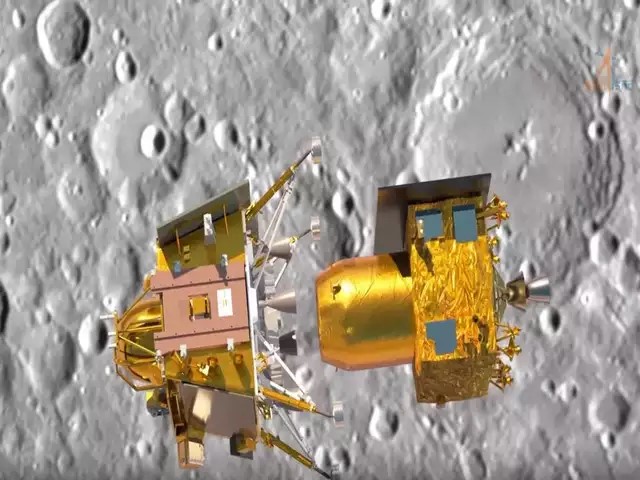- Get link
- X
- Other Apps
India's Chandrayaan-3 mission was a historic success, making India the fourth country to soft land on the moon and the first country to land on the lunar south pole. The mission was launched on August 22, 2022, and the lander module successfully touched down on the moon's surface at 5:34 a.m. PT (6:04 p.m. IST) on Wednesday, August 23, 2023.
The Chandrayaan-3 mission was a major milestone for India's space program, and it was a testament to the hard work and dedication of the scientists and engineers at the Indian Space Research Organisation (ISRO). The mission's success also showed that India is a major player in the global space race.
The Chandrayaan-3 mission was a challenging one, and it faced several obstacles along the way. The most difficult challenge was landing on the lunar south pole, which is a region that is covered in craters and has a very rough terrain. However, the ISRO team was able to overcome this challenge and successfully land the lander module on the moon's surface.
The Chandrayaan-3 mission was also a major technological achievement. The lander module was equipped with several advanced technologies, including a laser altimeter, a terrain mapping camera, and a magnetometer. These technologies allowed the lander to land safely on the moon's surface and to collect valuable scientific data.
 |
| Soft Landing of Chandrayaan-3 on Lunar South Pole |
 |
| Soft Landing of Chandrayaan-3 on Lunar South Pole |
The Chandrayaan-3 mission was a major success for India, and it will have a lasting impact on the country's space program. The mission's success has inspired a new generation of scientists and engineers, and it has shown the world that India is a major player in the global space race.
The people involved in the execution of this giant stride of the Lunar Mission of landing on the South Pole of the moon are:
- K Sivan, the former chairman of ISRO, was the driving force behind the Chandrayaan-3 mission.
- Anil Kumar Das, the project director of Chandrayaan-3, who was responsible for the overall execution of the mission.
- The team of scientists and engineers at ISRO, worked tirelessly to make the mission a success.
The Chandrayaan-3 spacecraft took 22 days to enter the Moon’s orbit on August 5th, following its launch from the Satish Dhawan Space Centre on July 14th. On August 17th, the Vikram lander carrying Pragyan - a lunar ground rover - successfully separated from its propulsion module in preparation for today’s soft landing.
This mission is a giant stride of the Lunar Mission of landing on the South Pole of the moon. It is a part of India's vision to explore space and expand its knowledge about space technology. The mission was executed by the Indian Space Research Organisation (ISRO) which is an Indian government agency responsible for India's space program.
Objectives for the Chandrayaan-3 mission
The Indian Space Research Organisation (ISRO) has set the following mission objectives for the Chandrayaan-3 mission:
- Getting a lander to land safely and softly on the surface of the Moon.
- Observing and demonstrating the rover's loitering capabilities on the Moon.
- In-site observation and conducting experiments on the materials available on the lunar surface to better understand the composition of the Moon.
Significance of landing on the South Pole of the Moon
The significance of landing on the South Pole of the Moon is that it is a little-explored area of the Moon that’s believed to contain water ice. The Moon’s South Pole is littered with deep craters and basins that are permanently shrouded in darkness. According to NASA, these areas haven’t seen sunlight in billions of years and can experience temperatures as low as negative 334 degrees Fahrenheit (negative 203 degrees Celsius). The extreme conditions in these "cold traps" make remote observation from Earth difficult and present problems for operating sensitive equipment in the region.
The significance of finding water on the Moon
The significance of finding water on the Moon is that it could be used as a resource for future missions to the Moon and beyond. Water can be broken down into hydrogen and oxygen which can be used as rocket fuel. This would make it easier and cheaper to launch missions from the Moon to other destinations in our solar system. Water could also be used for drinking and growing food which would make it easier for humans to live on the Moon for extended periods. The Pragyan rover will operate on the Moon's surface for one lunar day which is equivalent to around 14 Earth days. The Pragyan rover weighs 26 kg.
Conclusion
This mission is a giant stride of the Lunar Mission of landing on the South Pole of the moon. It is a part of India's vision to explore space and expand its knowledge about space technology. The mission was executed by the Indian Space Research Organisation (ISRO) which is an Indian government agency responsible for India's space program. The success of this mission will help India's space program to further explore the Moon and other planets in our solar system.

Comments
Post a Comment